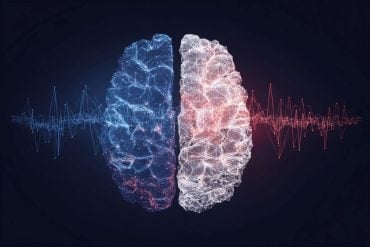Summary: Researchers have discovered that positive emotions enhance perceptual memories during sleep, particularly in the non-REM stage. Using mice, they found that memories linked to rewarding experiences lasted longer than neutral ones. The amygdala plays a key role in strengthening these memories by activating a tri-regional circuit with the motor and sensory cortices.
Brain recordings confirmed that this circuit reactivates during non-REM sleep, solidifying perceptual memories. Blocking amygdala signals during non-REM sleep disrupted memory retention, while blocking them during REM sleep had no effect. These findings suggest new ways to treat conditions like addiction and PTSD by targeting non-REM sleep processes.
Key Facts:
- Non-REM Memory Reinforcement: Emotionally linked perceptual memories are strengthened during non-REM sleep, not REM sleep.
- Amygdala’s Role: The amygdala, motor cortex, and sensory cortex work together to consolidate emotional memories.
- Potential Treatments: Modulating amygdala activity during non-REM sleep could help treat addiction and PTSD-related flashbacks.
Source: RIKEN
Researchers at the RIKEN Center for Brain Science (CBS) have uncovered how perceptual memories linked to positive emotions, such as joy or happiness, are strengthened during sleep.
The study, published in the scientific journal Neuron, could help scientists understand the neurological basis for overcoming conditions like drug or sexual addiction.

Why do emotional events, whether positive or negative, create strong, long-lasting memories of external information such as music, scene smells and textures received at the events?
We know that sleep is essential for memory consolidation, the process that turns new events into memories, but do not know how it plays its role in memory enhancement.
Experiments have shown that emotional events might be processed differently depending on the stage of sleep, but it is still unclear which part of sleep is more important for solidifying them, REM sleep—the time during sleep when we dream vividly—or non-REM sleep.
The new study led by Masanori Murayama at RIKEN CBS set out to answer this question.
The researchers first established mouse equivalents of neutral and emotional events so that they could examine what the brain does differently during sleep when emotions are involved.
In a neutral situation, male mice were allowed to explore only a smooth texture on day 1 of the experiment as a learning period and both grooved and smooth textures the next day as a testing period.
When their memory of the smooth texture was kept until day 2, they preferentially explored the grooved texture, but not smooth, texture because mice innately like novel environments.
However, when the smooth texture was paired with a positive emotional experience—interaction with a female mouse—the memory of the texture lasted much longer. Even with a four-day interval, at day 5, the mice still preferred the smooth texture, showing that this experimental setup could produce emotionally enhanced texture memory in mice.
As Murayama explains, “this is the first study to demonstrate perceptual memory enhancement through emotions in experimental animals. We were able to do so, and as a consequence, identified critical neural circuitry involved in perceptual memory enhancement.”
The researchers identified the amygdala, the brain’s emotional center, as key to this process.
The amygdala connects to a cortical top-down circuit from motor to sensory cortices which controls accurate perception and memory of texture information, as Murayama’s group previously discovered. This tri-regional circuit strengthens emotionally linked perceptual memories.
Brain recordings showed that these three brain regions were cooperatively activated in the learning periods and reactivated during early non-REM sleep, but not during REM sleep, to reinforce the memory.
To test the importance of the non-REM reactivation, the researchers temporarily prevented amygdala inputs to the motor cortex that sends top-down inputs to the sensory area.
When they did this during non-REM sleep, mice failed to retain the texture memory until day 5 despite the emotional experience. In contrast, blocking the signals during REM sleep had no effect, confirming that non-REM sleep is the key sleep stage for strengthening perceptual memories.
“Traditionally, REM sleep has been thought to be the primary stage for emotional memory processing,” says Murayama.
“Our findings challenge this idea and instead support non-REM sleep as the critical stage.”
This study not only explains how emotion enhances other types of memories (e.g., perception) but also points to potential treatments for conditions like addiction in which symptoms are sometimes triggered by perceptual information in a phenomenon called flashback. Such information is thought to be strongly memorized in connection with emotional events that occurred even long before the episodes.
By modulating brain activity in the amygdala and related regions during non-REM sleep to weaken perceptual memories that triggers flashbacks, doctors could potentially prevent or treat addiction.
Future research will explore how these findings apply to disease models, such as age-related memory decline or addiction.
“For instance, it will be important to examine whether we can recover or even strengthen memories in aged-mice,” says Murayama.
“Our ultimate goal is to use this knowledge to develop treatments that improve mental health and memory-related conditions.”
About this sleep and memory research news
Author: Masataka Sasabe
Source: RIKEN
Contact: Masataka Sasabe – RIKEN
Image: The image is credited to Neuroscience News
Original Research: Open access.
“Amygdalo-cortical dialogue underlies memory enhancement by emotional association” by Masanori Murayama et al. Neuron
Abstract
Amygdalo-cortical dialogue underlies memory enhancement by emotional association
Emotional arousal plays a critical role in determining what is remembered from experiences. It is hypothesized that activation of the amygdala by emotional stimuli enhances memory consolidation in its downstream brain regions.
However, the physiological basis of the inter-regional interaction and its functions remain unclear.
Here, by adding emotional information to a perceptual recognition task that relied on a frontal-sensory cortical circuit in mice, we demonstrated that the amygdala not only associates emotional information with perceptual information but also enhances perceptual memory retention via amygdalo-frontal cortical projections.
Furthermore, emotional association increased reactivation of coordinated activity across the amygdalo-cortical circuit during non-rapid eye movement (NREM) sleep but not during rapid eye movement (REM) sleep.
Notably, this increased reactivation was associated with amygdala high-frequency oscillations. Silencing of amygdalo-cortical inputs during NREM sleep selectively disrupted perceptual memory enhancement.
Our findings indicate that inter-regional reactivation triggered by the amygdala during NREM sleep underlies emotion-induced perceptual memory enhancement.






